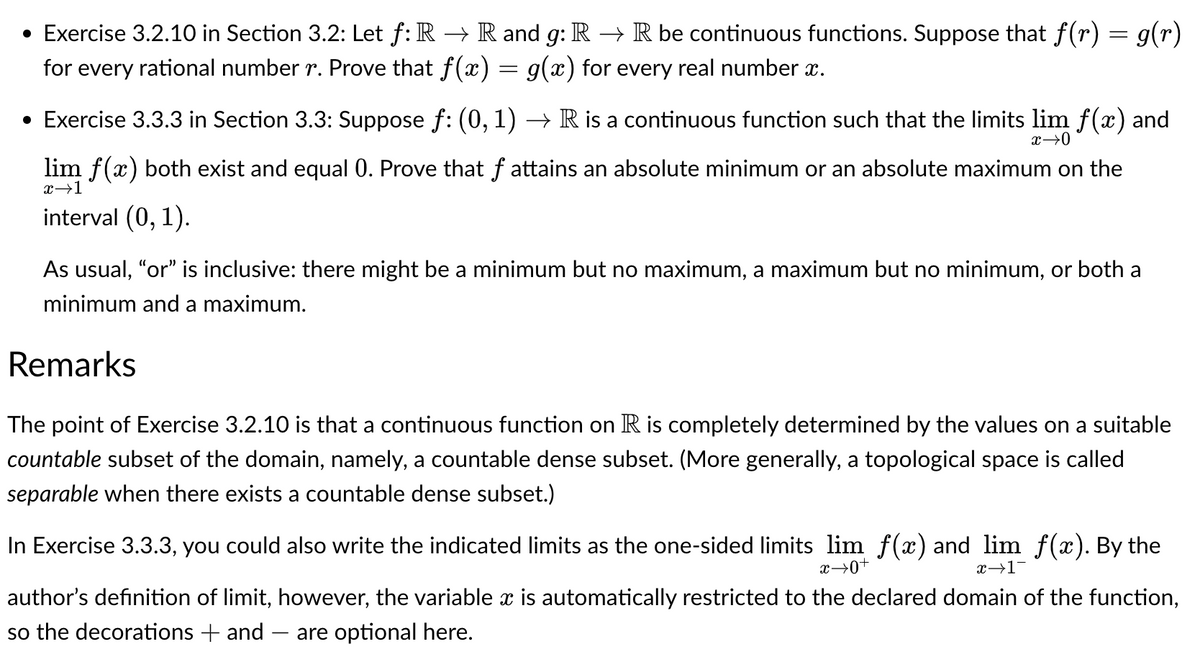• Exercise 3.3.3 in Section 3.3: Suppose f: (0, 1) → R is a continuous function such that the limits lim f(x) and x→0 lim f(x) both exist and equal 0. Prove that f attains an absolute minimum or an absolute maximum on the x→1 interval (0, 1). As usual, "or" is inclusive: there might be a minimum but no maximum, a maximum but no minimum, or both a minimum and a maximum.
• Exercise 3.3.3 in Section 3.3: Suppose f: (0, 1) → R is a continuous function such that the limits lim f(x) and x→0 lim f(x) both exist and equal 0. Prove that f attains an absolute minimum or an absolute maximum on the x→1 interval (0, 1). As usual, "or" is inclusive: there might be a minimum but no maximum, a maximum but no minimum, or both a minimum and a maximum.
Algebra & Trigonometry with Analytic Geometry
13th Edition
ISBN:9781133382119
Author:Swokowski
Publisher:Swokowski
Chapter5: Inverse, Exponential, And Logarithmic Functions
Section5.3: The Natural Exponential Function
Problem 52E
Related questions
Question
Please solve exercise 3.3.3 with detailed explanations

Transcribed Image Text:• Exercise 3.2.10 in Section 3.2: Let f: R → R and g: R → R be continuous functions. Suppose that f(r) = g(r)
for every rational number r. Prove that f(x) = g(x) for every real number î.
• Exercise 3.3.3 in Section 3.3: Suppose ƒ: (0, 1) → R is a continuous function such that the limits lim f(x) and
x →0
lim f(x) both exist and equal 0. Prove that f attains an absolute minimum or an absolute maximum on the
x→1
interval (0, 1).
As usual, "or" is inclusive: there might be a minimum but no maximum, a maximum but no minimum, or both a
minimum and a maximum.
Remarks
The point of Exercise 3.2.10 is that a continuous function on R is completely determined by the values on a suitable
countable subset of the domain, namely, a countable dense subset. (More generally, a topological space is called
separable when there exists a countable dense subset.)
In Exercise 3.3.3, you could also write the indicated limits as the one-sided limits lim f(x) and lim f(x). By the
x→1
x →0+
author's definition of limit, however, the variable x is automatically restricted to the declared domain of the function,
so the decorations + and are optional here.
Expert Solution
This question has been solved!
Explore an expertly crafted, step-by-step solution for a thorough understanding of key concepts.
This is a popular solution!
Trending now
This is a popular solution!
Step by step
Solved in 3 steps with 2 images

Recommended textbooks for you

Algebra & Trigonometry with Analytic Geometry
Algebra
ISBN:
9781133382119
Author:
Swokowski
Publisher:
Cengage

Linear Algebra: A Modern Introduction
Algebra
ISBN:
9781285463247
Author:
David Poole
Publisher:
Cengage Learning

Elements Of Modern Algebra
Algebra
ISBN:
9781285463230
Author:
Gilbert, Linda, Jimmie
Publisher:
Cengage Learning,

Algebra & Trigonometry with Analytic Geometry
Algebra
ISBN:
9781133382119
Author:
Swokowski
Publisher:
Cengage

Linear Algebra: A Modern Introduction
Algebra
ISBN:
9781285463247
Author:
David Poole
Publisher:
Cengage Learning

Elements Of Modern Algebra
Algebra
ISBN:
9781285463230
Author:
Gilbert, Linda, Jimmie
Publisher:
Cengage Learning,
